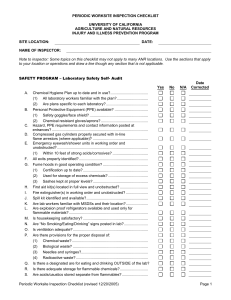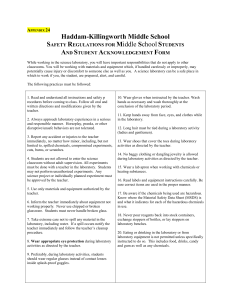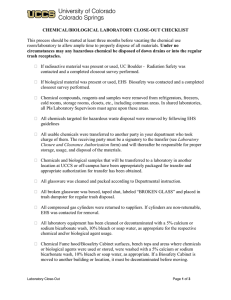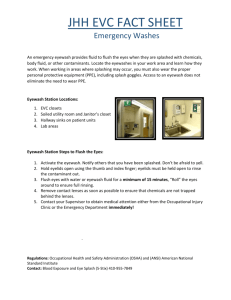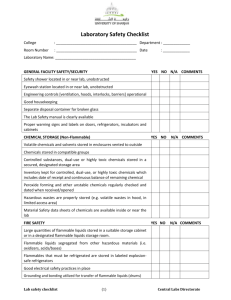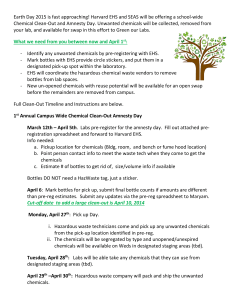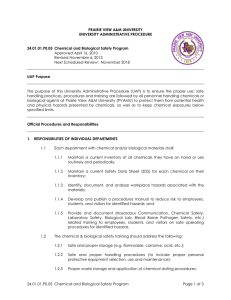Creating a Safety Culture - Georgia Tech Environmental Health and
advertisement
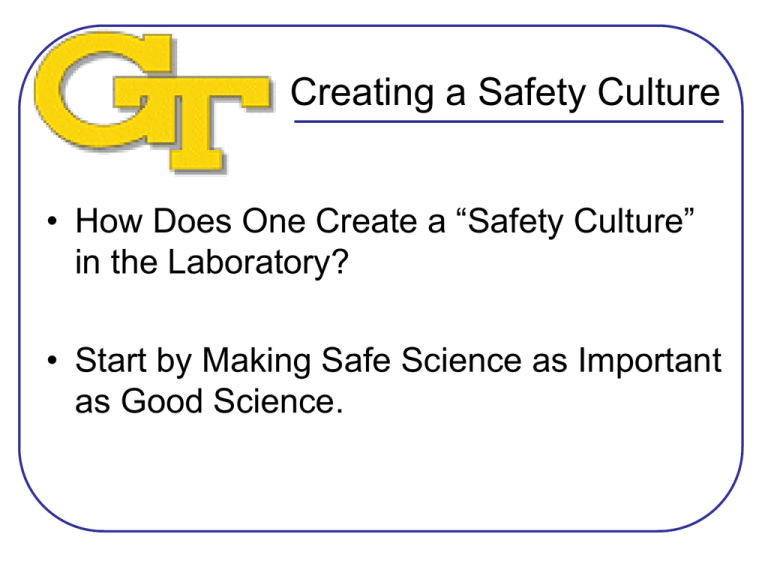
Creating a Safety Culture • How Does One Create a “Safety Culture” in the Laboratory? • Start by Making Safe Science as Important as Good Science. Creating a Safety Culture • Safety is No Accident – You have to MAKE it happen – That means • • • • Time Effort Resources Money Creating a Safety Culture Making Safety Happen • Assign and Empower Someone to: – Be responsible for Chematix compliance – Conduct weekly lab inspections – Conduct weekly eyewash checks – Conduct monthly fire extinguisher checks Making Safety Happen • EHS recommends that lab inspection and equipment check duties rotate weekly to different members of the group to give everyone a sense of “ownership” and responsibility for overall lab safety. Creating A Safety Culture Lab Self Inspections Should Look At: • • • • • • • Housekeeping Accessibility of Emergency Equipment Flush the eyewash/document Gas cylinders, restrained/capped when not in use/ number within allowances/ no toxic gases that have not been approved Spill kits- present, appropriate, and complete Hand washing facilities- soap and towels available Chemicals have Chematix labels- no one has been sneaking chemicals into the lab • • • • • • • Egress- Main aisles are 48” unobstructed/ others 36” unobstructed Doors not blocked Labeling- all in house labels are RTK compliant Waste is labeled appropriately, in secondary containment, and segregated as needed Electrical panels/boxes have 36” of open space in front Food in the lab Other issues specific to your lab- s/a calcium gluconate is easy to find Creating a Safety Culture Training1 Make Sure Group Members are Adequately Trained: • • • • • • • RTK-annually Fire Safety Training- once Basic Lab Safety-every 3 years On line waste training- every 3 years On line training for shipping- every 3 years On line training for gas cylinder handling Biosafety/Radiation Safety/Laser Safety as appropriate Creating a Safety Culture Training2 • Lab Inspectors are required to verify that lab users have had adequate training to be in the lab. • Place copies of training certificates in an envelope posted near the door. Creating a Safety Culture Training3 Create a New Lab User Orientation List • Cover things like exit locations, emergency equipment, PPE and attire requirements, evacuation procedures, hazards that are unique to your lab s/a specific chemicals or equipment • Have the new person sign the list when you are done- File it. Creating a Safety Culture SOPs • Create a library of Standard Operating Procedures for everything you do routinely-keep it in a notebook • For highly hazardous procedures- add a signature page and make everyone read and sign that they have read it Creating a Safety Culture Pre-Planning • Teach your group members to plan their experiments from start (virgin chemicals & equipment) to end (waste) • Make locating everything needed ahead of time a requirement per the SOP Creating a Safety Culture Surprise Safety Drills1 • Announce to your group members that you (or one of your senior staff) will be holding “surprise drills” A few days later, have a senior staff member hand someone in the lab (chosen at random) an index card that says one of the following things• This is a drill, please demonstrate the proper procedure as if you had – Just splashed acid in your eyes – Just spilled sodium hydroxide in your lap – A fire break out on your lab bench Creating a Safety Culture Lab Drills2 • Group members would not be required to actually pull the shower ring, for example, but they would be required to move to the closet shower/eyewash/ fire extinguisher quickly and without prompting to demonstrate that they know were it is and how to turn it on. Creating a Safety Culture Annual Lab Clean Outs1 • Make lab clean outs an annual event that everyone must take part in (don’t just dump it on your lab manager) • Make attendance mandatory for all group members to ensure that they are active participants in the safety process. Creating a Safety Culture Annual Lab Clean Outs2 • Work best when done in conjunction with one of the chemical inventory reconciliations- get rid of aging PECs and things you don’t use anymore (this includes samples). Georgia Institute of Technology Creating a Safety Culture Annual Lab Clean Outs3 • Graduating students are required to clean out their space (and freezer storage) and dispose of left-over chemicals prior to leaving the lab group (or receiving their last pay check). Georgia Institute of Technology Creating a Safety Culture Monthly Safety Meetings1 • Hold monthly meetings• Your most valuable resource is your time. • If you don’t demonstrate that safety is important to you by taking a little time out of your busy schedule every month to talk about safety– Then nobody is going to pay attention to anything you say! Creating a Safety Culture Monthly Safety Meetings2 • Can be part of a another meeting • Don’t have to be very long • You can talk about recent events, drills, near misses, spills, etc. • You can use them to show safety videos borrowed from EHS. • You can bring in guest speakers on a safety topic of your choosing (EHS does requests) Creating a Culture of Safety • Set a Good Example• Rules about hygiene, Personal Protective Equipment (PPE), and proper attire won’t mean anything if you don’t follow them yourself: • Neither will they mean anything if you won’t correct the behavior of subordinates who don’t follow them. Creating a Culture of Safety • The time and effort that you expend on safety will be directly reflected in the safety practices of your group members



